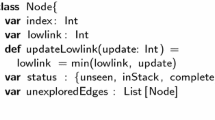Abstract
We consider a simple model of a linear systolic array with serial input/output and one-way data communication. We show that such an array can be used to solve some scheduling and graph problems efficiently. The systolic algorithms are developed in two stages. First an algorithm on a restricted type of sequential machine is constructed. Then the sequential machine algorithm is transformed into a systolic algorithm. The transformation can be done automatically and efficiently.
Similar content being viewed by others
References
H.-T. Kung and M. Lam, “Fault-tolerance and two-level pipelining in VLSI systolic arrays,”Proc. 1984 Conference on Advanced Research in VLSI, Ed. Paul Penfield, Jr. Dedham, MA: Artech House, pp. 74–83.
C. Savage and M. Stallmann, “Decomposability and fault-tolerance in one-dimensional array algorithms,” 1987. In preparation.
K. Baker,Introduction to sequenching and scheduling, New York: Wiley, 1974.
G. Gallo, “An O(n log n) algorithm for the convex bipartite matching problem,”Oper. Res. Lett., vol. 3, 1984, pp. 31–34.
F. Glover, “Maximum matching in a convex bipartite graph,”Naval Res. Logist. Quart, vol. 14, 1967, pp. 313–316.
E. Horowitz and S. Sahni,Fundamentals of computer algorithms, Rockville, MD: Computer Science Press, 1978.
O. Ibarra, M. Palis, and S. Kim, “Some results concerning linear iterative (systolic) arrays,”Journal of Parallel and Distributed Computing, vol. 2, 1985, pp. 182–218.
J. Van Leeuwen and M. Nivat, “Efficient recognition of rational relations,”Inform. Processing Lett., vol. 14, 1982, pp. 34–38.
O. Ibarra, S. Kim, and M. Palis, “Designing systolic algorithms using sequential machines,”IEEE Trans. on Comput., vol. 35, 1986, pp. 531–542.
J.A.B. Fortes and F. Parisi-Presicce, “Optimal linear schedules for the parallel execution of algorithms,”Proc. International Conference on Parallel Processing, 1984.
G.J. Li and B.W. Wah, “The design of optimal systolic arrays,”IEEE Transactions on Computers, vol. C-34, 1985, pp. 66–77.
D.I. Moldovan, “On the design of algorithms for VLSI systolic arrays,”Proc. IEEE, vol. 71, 1983, pp. 113–120.
M.T. O'Keefe and J.A.B. Fortes, “A comparative study of two systematic design methodologies for systolic arrays,”Proc. International Conference on Parallel Processing, 1986, pp. 672–675.
U. Gupta, D. Lee, and J. Leung, “An optimal solution for the channel-assignment problem,”IEEE Trans. on Comput., vol. C-28, 1979, pp. 807–810.
E. Dekel and S. Sahni, “A parallel matching algorithm for convex bipartite graphs and applications to scheduling,”J. of Parallel and Distributed Computing, 1, 1984, pp. 185–205.
Author information
Authors and Affiliations
Additional information
This research was supported in part by NSF Grants DCS-8304756, DCR-8420935, and DCR-8604603.
Rights and permissions
About this article
Cite this article
Ibarra, O.H., Jiang, T., Chang, J.H. et al. Systolic algorithms for some scheduling and graph problems. J VLSI Sign Process Syst Sign Image Video Technol 1, 307–320 (1990). https://doi.org/10.1007/BF00929924
Received:
Revised:
Published:
Issue Date:
DOI: https://doi.org/10.1007/BF00929924




